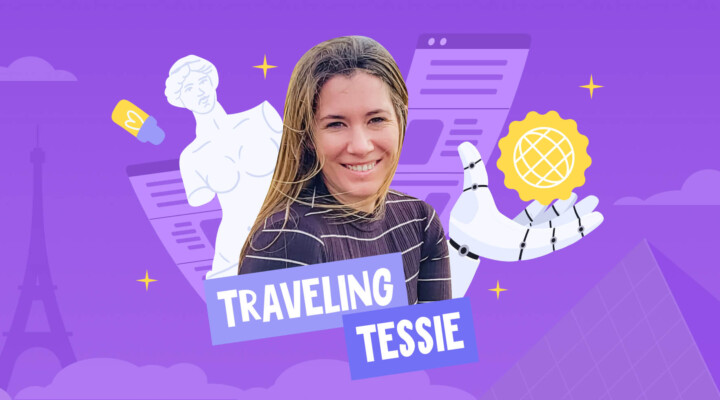Why Solo Travel Is on the Rise: Understanding the Shift in Traveler Preferences
The rise in the independent travel market can be attributed to factors emphasizing independence and authenticity. One significant reason is the desire for self-discovery and personal growth. Traveling alone allows individuals to step out of their comfort zones, face challenges, and foster a deeper understanding of themselves and their world — à la Eat, Pray, Love.
Additionally, solo travel provides greater flexibility and freedom when planning and executing a trip. Travelers can create their itineraries, decide on the pace of their journey, and make last-minute changes without consulting or compromising with a travel companion.
Technological advancements, such as the ubiquity of smartphones and the internet, have made it easier than ever for solo travelers to stay connected, research destinations, and navigate unfamiliar places. International phone plans and unlimited data mean you no longer have to stress about getting lost. The world is at your fingertips if your battery doesn’t run out.
Along with technological advances, societal attitudes toward solo travel have evolved. People have become more comfortable venturing out independently. Solo female travel, for example, is no longer a foreign concept. In fact, most solo travelers are female (84%), with only 16% being male. Plus, the rise of solo travel communities has made it easier for travelers to connect, share experiences, and offer support, further encouraging the growth of this trend.
Ultimately, the rise of solo travel is driven by shifting traveler preferences that prioritize independence, authenticity, and personal growth. This growing market segment presents a prime opportunity for affiliate marketers to cater to independent travelers’ unique needs and interests.
Who Are Solo Travelers?
But who are these solo travelers? Understanding the demographics and characteristics of solo travelers is crucial for affiliate marketers looking to tailor their campaigns to this market. Solo travelers come in all shapes and sizes. Millennials, Gen Z, and baby boomers all travel solo, but each group values different experiences.
Some solo travelers, such as solo female travelers, prioritize safety and female-friendly accommodations, while others, like adventure seekers, are more interested in thrilling outdoor activities. Digital nomads combine work and travel, representing another growing segment within the solo travel market. These individuals often seek tools, resources, and accommodations catering to their unique needs. Budget-conscious travelers and cultural explorers also form significant portions of the solo travel market, seeking affordable options and immersive cultural experiences, respectively.
Selecting a Solo Niche
When selecting a niche within the solo travel market, it’s crucial to pinpoint the specific group of solo travelers you aim to target, as each segment possesses its own unique needs and desires. Here is where you need to be as detailed as possible. Instead of just solo female travel, how about solo female travel for women over 40? As you can imagine, the needs of a 20-something solo traveler and a 40-something female traveler can differ.
Using statistics, let’s look at an example. According to the Wandering RV, 86% of solo travelers are 35 or older, with an average of around 47 years old. The majority of travelers look for unique and non-touristic experiences. Females, in particular, feel like Europe is one of the safest destinations for solo travel. With just these stats, we can start identifying our ideal niche and painting an affiliate marketing picture of the type of content we can write and products/services we can promote.
So what solo niche will you target? Once you’ve established your niche, you must understand your target audience’s pain points.
Addressing Pain Points
A pain point is a specific problem or challenge a target audience faces that causes discomfort or distress. In affiliate marketing, understanding and addressing pain points is crucial because it allows you to create content and offer recommendations for products or services that directly address your audience’s concerns. By addressing these issues, you build trust with your readers and demonstrate the value of your recommendations.
Solo travelers often face common concerns such as safety, loneliness, and language barriers. They might be worried about navigating unfamiliar places, finding connections, and communicating with locals. By identifying these pain points, you can tailor your content to offer solutions that cater to their unique needs and preferences.

However, every pain point allows you to recommend a product or service that addresses and resolves that issue. By providing solutions, you showcase your understanding of your audience’s needs and position yourself as a reliable source of information.
So, what are some opportunities for affiliate partners to capitalize on these pain points? Let’s delve into some possibilities.
Opportunities for Affiliate Partners
The growing solo travel market offers numerous opportunities for affiliate marketers to promote a wide range of products and services that cater to the unique needs of independent travelers. Here are some affiliate programs for solo travelers and ways to promote them effectively:
- Accommodation: Solo travelers often seek accommodations that provide safety, comfort, and opportunities for social interaction. Promote options like hostels on HostelWorld, boutique hotels on Booking.com, and long-term rentals that cater to these preferences. Quick tip, instead of promoting Airbnb for long-term rentals, why not focus on VRBO?
- Travel gear: High-quality, lightweight, and functional travel gear is essential for solo travelers. Partner with online retailers like Amazon or REI to promote products like backpacks, packing cubes, and travel gadgets through reviews, comparisons, and gear lists.
- Tours and activities: Many solo travelers appreciate organized tours and activities that offer immersive experiences and opportunities to connect with fellow travelers. Promote local tours, cooking classes, and adventure activities by partnering with platforms like GetYourGuide or Viator.
- Travel insurance: Safety is a top priority for solo travelers, making travel insurance an essential product to promote. Partner with reputable providers like EKTA and create content that educates your audience on the importance of travel insurance and how it can provide peace of mind during their trips.
- Transportation: Solo travelers often rely on various transportation options to get around. Use flight, train, and bus booking platforms like Kiwi.com, Omio, Rail Europe, or FlixBus. And if someone’s flights get canceled or delayed, you can also recommend programs like AirHelp.
- Language learning and communication tools: To overcome language barriers, solo travelers may use language learning apps and communication tools. Promote resources like Rosetta Stone, Duolingo, or Babbel, and earn commissions on subscriptions or app downloads.
When promoting these products and services, create engaging and informative content that showcases their benefits and relevance to solo travelers. Use a mix of blog posts, videos, and social media content to reach your audience and drive traffic to your affiliate links.
Building a Solo Travel Affiliate Marketing Business
Now that you know the types of opportunities for solo travel affiliate marketing, how can you start building your own solo travel affiliate business—or at least tap into this growing market?
1. Start With a Niche
Building a successful solo travel affiliate marketing business begins with niche selection. Selecting a specific niche within solo travel, such as adventure or solo female travel, is essential to cater to a more focused audience. And if you can, go deeper. For example, instead of just female solo travel, you can niche down further, like solo travel for single moms or female solo travel for retirees.
To learn more about the importance of choosing a niche, watch this video from Travelpayouts Academy.
💡 However, if you don’t want to start a whole new blog focusing on solo travel, there are ways of reaching this market segment with your current blog or website. All you need to do is create content that fits within the theme of your blog while still addressing the unique needs of the solo travel market.
For example, let’s say you have a blog about travel in Portugal. We know that most female solo travelers travel to Europe due to safety concerns, and Portugal is one of the safest destinations to travel to in all of Europe. If we go to Keysearch and search for solo female travel in Portugal, several keywords pop up that we can use for a blog article. Perfect!

Remember that, along with identifying your niche, you must also understand your audience’s unique needs, preferences, and pain points. If you aren’t sure what their needs are, research and interact with your target audience through social media, forums, and blog comments.
2. Nail SEO
SEO is vital in affiliate marketing. As mentioned earlier, to effectively connect with your target audience, it’s essential to identify their pain points and conduct thorough keyword research. Aim for high-volume, low-competition keywords.
Remember, the traveler’s journey often progresses through different stages, from inspiration to research, planning, booking, and finally, experiencing their trip. In your blogging journey, you should focus on keywords that touch all these different stages.
Nonetheless, the highest number of conversions for affiliate marketing is likely to be achieved through keywords associated with the booking or purchasing phase. Creating well-optimized content tailored to travelers prepared to make decisions can not only increase your site’s visibility and drive organic traffic, but it can also increase conversion rates.
To gain a better understanding of how you can use SEO to boost your affiliate marketing efforts, take a free SEO course with expert Sharon Gourlay.
3. Create Unique, Yet Practical Content
Solo travelers want more than just a sales pitch; they want to learn from genuine experiences. Use storytelling to share personal anecdotes and offer recommendations based on firsthand knowledge. This approach builds trust and makes your content more relatable.
While storytelling is essential, you should also share practical information not readily available elsewhere. Offering valuable guidance and insights can empower solo travelers to plan and embark on their adventures with confidence. Demonstrating your expertise will boost your credibility and increase the likelihood of driving conversions.
4. Keep It Fresh
What does this mean exactly? Links expire, activities become unavailable, and information can become outdated. As a result, you should continually update your content and check the validity of all your recommendations. Updating older blog posts, staying up to date on SEO trends and updates, and ensuring links are working while activities are still bookable are all part of the blogging process.
5. Build a Community
As you write, you should also start creating and building your community. Communities are an excellent way to connect with your audience, build trust, and foster long-lasting relationships. By offering multiple avenues for engagement, you create an environment where your followers feel valued and heard.
There are various ways to build a community, such as creating a Facebook group, hosting webinars, or engaging with your audience via email. These platforms offer opportunities to share your insights, experiences, and recommendations while fostering loyalty and trust with your audience.
6. Monetize
Finally, monetize your platform by partnering with relevant affiliate programs that offer products and services your audience needs. Diversify your income streams by incorporating display ads, sponsored content, and digital products alongside your affiliate marketing efforts.
Platforms like Travelpayouts make affiliate marketing simple by consolidating everything in one place, allowing you to focus on other aspects of your business. This convenience streamlines the process and ensures you can dedicate more time to creating valuable content.
Join the Travelpayouts partnership platform
Streamline your travel blog's financial success.
Join todayAnd above all else, continuously track, analyze, and optimize your campaigns to maximize conversions and ensure the long-term success of your solo travel affiliate business. And remember, be strategic.
The Potential of Solo Travel Affiliate Marketing
The potential of the solo travel affiliate marketing industry is vast and accessible to anyone willing to invest time and effort into their business. Remember to approach it professionally, treating it as a business rather than a hobby. Prioritize organization and consistency, and never underestimate the importance of SEO for your affiliate marketing success.
By following these guidelines and consistently delivering valuable content, you can successfully build a thriving solo travel affiliate marketing business, tapping into the growing demand for tailored solutions in this niche.




